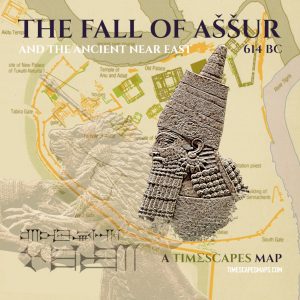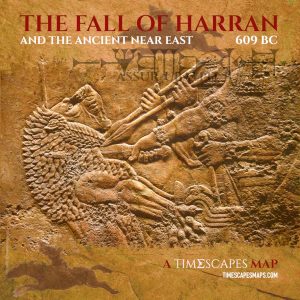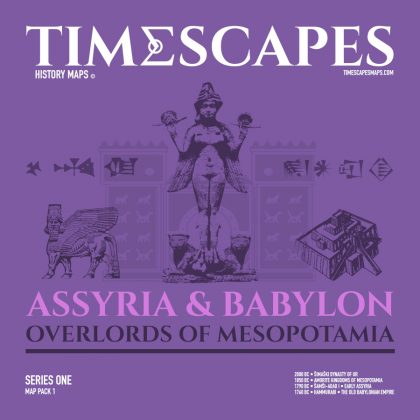
Timescapes Map Pack 5 – Kingdoms of Iron – The Iron Age
- 1000 BC: ANATOLIAN & CANAANITE KINGDOMS
- 830 BC: ŠALMANESER III – RISE OF NEO-ASSYRIA
- 700 BC: SENNACHERIB – THE NEO-ASSYRIAN EMPIRE
- 631 BC: THE DEATH OF AŠŠURBANIPAL
Plus:
From the chaos and upheaval of the 12th and 11th centuries, a new political map of the Near East began to emerge comprising many smaller kingdoms and city-states, propelled by the new technology of iron. One military culture exploited iron more efficiently than any other: by the end of the 9th century BC, the Neo-Assyrian kings had begun to assert increasing control over their neighbours, and the rest of the first half of the millennium is a long story of Assyrian conquest, culminating in the vast empire of Aššurbanipal, and shortly thereafter the violent end of ancient Assyria at the hands of the Medes and Babylonians.
TIMESCAPES MAP PACK 5 – THE IRON AGE
1000 BC: ANATOLIAN & CANAANITE KINGDOMS
The fall of the mighty empire of the Hittites led to the rise of many smaller states and kingdoms: Lydía, Karía and Phrygía in Anatolia, and the Neo-Hittite states in Syria.
Egypt was attacked by the Sea Peoples but held firm, although its borders receded to its heartland as new, energetic kingdoms such as Judah, Israel and Aram arose in Canaan and the Levant.
The Phoenician states also weathered the storm, continuing to prosper.
The Middle Assyrian empire, which had survived the chaos of the Bronze Age Collapse, expanded, taking control of the former Hittite and Mitanni territories in Mesopotamia.
With the fall of Mycenae, Greece entered a dark age from which it would not fully emerge until the dawn of the 8th century BC.

TIMESCAPES MAP PACK 5 – THE IRON AGE
830 BC: ŠALMANESER III – RISE OF NEO-ASSYRIA
Šalmaneser III was the son of Aššurnasirpal II, one of the most ruthlessly efficient Assyrian kings, who between 883-859 BC had vastly expanded the frontiers of the Neo-Assyrian empire.
His was a difficult reign to follow but his son proved to be equally zealous in his expansion of the empire.
The Assyrian military machine had continued to benefit from increased wealth and innovations in technology, particularly in the field of siege warfare and by the end of Šalmaneserʼs reign Assyriaʼs borders stretched westwards as far as the Taurus Mountains.
To the south, Babylonia, almost constantly the stage for anti-Assyrian intrigue, remained on friendly terms for the whole of Šalmaneserʼs reign, testament to his talent for diplomacy in addition to his prowess as a military commander.

TIMESCAPES MAP PACK 5 – THE IRON AGE
700 BC: SENNACHERIB – THE NEO-ASSYRIAN EMPIRE
Sennacheribʼs traits as a ruler have divided scholarly opinion: many have regarded him as cruel and tyrannous and his own inscriptions seem to revel in the extreme acts of punishment he inflicted on those who opposed him; still, in this regard he could scarcely be distinguished from those who preceeded or succeeded him.
Others have suggested a more complex portrait of a king who may have suffered from a personality disorder, possibly related to the fate that befell his father Sargon II, who was killed in battle with the Tabalians and whose body was never recovered.
Sennacherib appears to have differed from many other Assyrian rulers in that he was not obsessed with conquest, preferring to let his generals take command of military campaigns.
He certainly ensured that Assyriaʼs military domination remained unchallenged, recapturing some Assyrian territories which had been lost and quelling a series of uprisings, but he seems to have been more invested in his large-scale building projects, such as the expansion and decoration of the Assyrian capital Kalhu (Nimrud), than in war.

TIMESCAPES MAP PACK 5 – THE IRON AGE
631 BC: THE DEATH OF AŠŠURBANIPAL
The death of Aššurbanipal in 631 BC signalled the beginning of the end for Assyria.
It had taken a ruler of immense power and energy to acquire and administrate the by now vast empire which stretched from the shores of the eastern Mediterranean to the Persian Gulf and encompassed most of Egypt.
His successors were not made of the same stuff and piece by piece the Assyrian empire began to break apart as its subject nations, sensing weakness, seceded one by one from Assyrian rule.
A mere 15 years after Aššurbanipalʼs death, Assyriaʼs great cities were attacked and conquered by a coalition of Medes and Babylonians.
BONUS MAPS – THE FALL OF ASSYRIA

TIMESCAPES MAP PACK 5 – Bonus Maps
614 BC: THE FALL OF AŠŠUR
In 614 BC the fall of Aššur, the spiritual home of the Assyrian identity, was the first in a series of traumatic shocks to Assyrian power.
Aššur, named after the supreme deity of Assyria, was the most ancient of the Assyrian cities, inhabited since at least the middle of the 3rd millennium BC.
Only once before had it fallen to an invading army, when the mighty Babylonian king Hammurabi had defeated Išme-Dagan I and incorporated it into his Old Babylonian empire. But that had been nearly a thousand years ago, when Assyria was a relatively small kingdom.
This conquest signified the beginning of the end for one of the most powerful empires of the ancient world.

TIMESCAPES MAP PACK 5 – Bonus Maps
612 BC: THE FALL OF NINEVEH
The great city of Nineveh was by all accounts one of the most spectacular and impressive cities of the ancient world.
The legendary Hanging Gardens of Babylon are now considered by many archaeologists to have been actually built by Sennacherib at Nineveh, during his enormous building projects of the early 7th century BC.
Its importance as a religious site, however, reached back to at least 2500 BC, when it is known to have been a centre of worship for the goddess Ishtar.
The Fall of Nineveh was one of the most significant and symbolic events of the ancient world. For nearly a thousand years the Assyrians had dominated most of their neighbours, ruling with a cruelty that would not be forgotten when the time came for the tide of power to turn.
Both the Medes and the Babylonians had suffered considerably at the hands of their former overlords and when the Median army of Cyaxares, soon followed by the Babylonian forces of Nabopolassar, breached the walls of the Assyrian capital in 612 BC, little mercy would have been shown to the inhabitants.

TIMESCAPES MAP PACK 5 – Bonus Maps
609 BC: THE FALL OF HARRAN
After the destruction of the great cities of their heartland, the Assyrians retreated westwards, establishing a capital in Harran.
For three years, under their king Aššur-Uballit II, the Assyrian court and people, though greatly reduced, survived. But it was a brief respite: two years later, the combined forces of Nabopolassar of Babylon and Cyaxares of the Medes arrived at the gates of Harran, intent on completing the total destruction of their former tormentors.
After a protracted siege, the city finally fell in 609 BC.
Whether or not Aššur-Uballit had already fled, whether he was killed at Harran and how much of an army remained at Harran is not clear from the existing sources. Once again though, the Assyrians survived, continuing their westwards retreat to Karkemiš, where they established what was to be their final capital.

TIMESCAPES MAP PACK 5 – Bonus Maps
605 BC: THE FALL OF KARKEMIŠ
The empire of Assyria finally collapsed completely in 605 BC.
For all practical purposes, the empire had been lost some years previously with the destruction of the great cities of the Assyrian heartland, culminating in the fall of Nineveh in 614 BC.
The final stand of the Assyrians was staged at the battle of Karkemiš, where, despite assistance from the armies of Necho II of Egypt, the 800 year empire of Assyria was finally extinguished forever.












